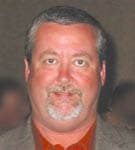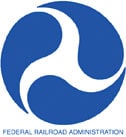
He is survived by his wife, Hardy; sons Whit and Jonathan; daughter Jennifer, and grandson, Caleb.
The family requests that in lieu of flowers, donations be made to Shriners Children’s Hospital, 950 West Faris Rd., Greenville, S.C. 29605, or a charity of one’s choice.
“We have all lost a brother, a good friend and a most effective state legislative director,” said UTU National Legislative Director James Stem.
Tag: James Stem

The UTU and Sheet Metal Workers International Association – now combined into the Sheet Metal, Air, Rail and Transportation Workers (SMART) – along with other labor organizations, public interest groups, congressional Democrats and moderate Republicans are working on Capitol Hill to block these attempts, which could be devastating to working families.
UTU National Legislative Director James Stem and SMWIA Director of Governmental Affairs Jay Potesta outlined the conservatives’ agenda that has surfaced in proposed congressional transportation reauthorization and budget legislation:
* Cut $31.5 billion in federal transportation spending, which would threaten some 500,000 American jobs.
* Eliminate federal spending for Amtrak and expansion of intercity rail-passenger service and high-speed rail, with a direct impact on jobs associated with that service.
* Gut federal spending for the Alaska Railroad, which would force elimination of scores of train and engine workers represented by the UTU.
* Delay implementation of positive train control, which is a modern technology to reduce train accidents and save lives and limbs.
* Eliminate federal spending for expansion of local and regional transit service as Americans scramble to find alternatives to driving in the face of soaring gasoline prices. The federal spending cut would prevent the return to work of furloughed workers from budget-starved local transit systems and likely cause layoffs of still more transit workers.
* Encourage privatization of local transit systems, which would open the door for non-union operators eager to pay substandard wages and eliminate employee health care insurance and other benefits.
* Remove any requirement for shuttle-van operators, whose vehicles cross state lines, from paying even minimum wage or overtime – a proposal, which if enacted, could lead to applying that legislation to interstate transit operations.
* Eliminate Railroad Retirement Tier I benefits that exceed Social Security benefits even though railroads and rail employees pay 100 percent of those benefits through payroll taxes, with no federal funds contributing to Tier I benefits that exceed what is paid by Social Security.
* Replace direct federal spending on Medicare in favor of handing out vouchers to be used to purchase private insurance, which will undercut the viability of Medicare.
* Provide large tax breaks to millionaires and preserve tax breaks for Wall Street hedge funds that cater to the wealthy, while cutting by two-thirds federal assistance to veterans and public schools.
The UTU member-supported political action committee (PAC) is helping to fund election campaigns by labor-friendly candidates, and a labor-wide “get out the vote” drive will go door-to-door across America in support of labor-friendly candidates in advance of November elections.
In the meantime, UTU and SMWIA legislative offices will continue their education campaign on Capitol Hill, visiting congressional offices to explain the economic devastation the current conservative agenda would impose on working families.

PTC utilizes the satellite global positioning system (GPS), wireless communications and central control centers to monitor trains and prevent collisions by automatically applying the brakes on trains exceeding authorized speeds, about to run a red light, violate a work zone or run through a switch left in the wrong position.
For two decades, the National Transportation Safety Board has had PTC installation at the top of its public-safety objectives. The UTU worked with labor-friendly lawmakers to include a mandate for PTC installation in the Rail Safety Improvement Act of 2008, with a 2015 implementation deadline.
However, the Association of American Railroads, which represents the freight railroad industry – and which 30 years ago was an aggressive proponent of an earlier version of PTC, called Advanced Train Control Systems – is lobbying Congress for a multi-year delay in widespread PTC installation, while offering other options for safety improvements instead of PTC.
Citizens for Responsibility and Ethics in Washington says lawmakers supporting the lengthy delay – including House Transportation & Infrastructure Committee Chairman John Mica (R-Fla.) and House Rail Transportation Subcommittee Chairman Bill Shuster (R-Pa.) – are among the biggest recipients of freight-railroad campaign contributions.
Some commuter railroads and Amtrak view matters quite differently – especially Los Angeles Metrolink, where 25 people died and 135 were injured in a 2008 head-on train accident at Chatsworth, Calif., that safety experts say could have been prevented had PTC been in place.
Amtrak (on track it owns), Metrolink, Chicago Metra and Southeast Pennsylvania Transportation Authority (SEPTA) — in conjunction with owners of track over which they operate — are among commuter systems striving to have PTC operational as early as 2013. Sen. Dianne Feinstein (D-Calif.) said BNSF will meet the current 2015 implementation date.
Sadly, according to news reports, 24 other commuter railroads and the American Public Transportation Association place a higher priority on spending for gussied up passenger stations, platforms and even new office buildings for executives, and are supporting the delay in PTC implementation.
Los Angeles Metrolink President John Fenton, who adamantly places safety first, told Congress, “We don’t think there is any time to waste given the unforgiving nature of the environment in which we operate.” In bitter memory of the Chatsworth disaster, Fenton and Metrolink employees wear green wrist bands with the words, “Never Again.”
Metrolink is leading the fight against any delay in widespread PTC implementation, explaining that PTC installation costs would be far lower were PTC architecture and components purchased in greater quantity, which would create vendor competition, introduce standardization and spread overhead costs among all railroads.
“PTC can be the technological edge that helps Metrolink achieve the safest operations possible,” says Fenton. “We believe PTC is perhaps the most important safety innovation in our lifetime.”
UTU National Legislative Director James Stem and Alternate National Legislative Director John Risch have been delivering a single message to Congress: “Implementation of PTC is a small price to pay for saving lives and limbs. We need this modern technology safety overlay to protect passengers, the public and train crews.”

In a Notice of Proposed Rulemaking published Feb. 7 in the Federal Register, the FRA said affected employees would have to be trained and qualified in federal rail safety laws, regulations and orders. Those affected include train and engine workers, maintenance-of-way employees, and workers who inspect and repair freight and passenger cars and locomotives.
The FRA proposes that each railroad or contractor develop a training program designating the qualifications of each employee and them submit that program for agency approval. The training would consist of proficiency-based, incremental training modules, with workers required to demonstrate proficiency in one area before being permitted to accept additional instruction.
Employers would then be required to conduct periodic oversight of their own employees to determine compliance, and conduct annual written reviews of their training programs to close performance gaps.
The proposed rule is a requirement of the Rail Safety Improvement Act of 2008.
“Well-designed training programs have the potential to further reduce risk in the railroad environment,” said FRA Administrator Joe Szabo. “Better training can reduce the number of accidents, particularly those caused by human factors, which account for the vast majority of reportable accidents each year.”
The proposed new rule was developed with the input from officials in numerous federal and state government agencies, industry and labor.
UTU National Legislative Director James Stem said, “We need to start at the end of the pipeline. When you have a student, a new employee or an existing employee who is being trained on new equipment or new operating practices, what skills do we expect that employee to possess at the end of the training process? And then we’ll work back from that.”
Stem said many railroads, seeking to reduce training costs, have delivered self-directed, computer-based training, “leaving workers unprepared for the hazards of the job. Where there’s no instructor in the room, and all of the available information for the student is on the screen, if the student doesn’t understand the question, he or she has no one to ask. That student is then sent to the field.”
Stem said the proposed rule would create nationwide uniformity in training.
To read the FRA’s Notice of Proposed Rulemaking, click on the following link:
www.fra.dot.gov/rcc/pages/fp_321.shtml and then click on “Notice of Proposed Rulemaking”.
WASHINGTON – It’s now official. Conductor certification, mandated by the Rail Safety Improvement Act of 2008, became effective Jan. 1.
In a final rule, published by the Federal Railroad Administration Nov. 9, railroads were ordered to implement, by Jan. 1, a formal training program for certifying conductors and a formal process for training prospective conductors, thus ensuring job competency.
The FRA’s final rule on conductor certification follows many of the provisions of locomotive engineer certification, with a number of improvements the UTU, joined by the BLET, was able to obtain.
Following are highlights of the final rule, which ran almost 300 pages in the Nov. 9 Federal Register.
* While the railroad and its employees must comply with the final rule, there is no limitation on any rights the employee may have under a collective bargaining agreement
* Conductors currently employed will be grandfathered for from one to three years, with one-third of those conductors required to be tested for certification in 2012, 2013 and 2014. Beginning in 2015, one-third of the total conductor workforce will be recertified each year.
* Each railroad, in submitting its proposed certification program to the FRA for approval, must simultaneously submit it to the presidents of the UTU and BLET, which will have 45 days to comment. The intent is to encourage coordination by carriers with local union officers in formulating the certification program, and to gain a supporting statement from the general committee of jurisdiction.
* A conductor losing certification may work as an assistant conductor, brakeman, yard helper, switchman or utility employee, but cannot work as a locomotive engineer. If that individual holds both conductor and engineer certification, and the engineer certification is revoked, they may not work as a conductor.
* If the conductor certificate is revoked because of failing to control a train, violation of train speed, violation of brake test requirement, occupying main track without proper authority, tampering with safety devices, or an alcohol or drug violation, the decertified conductor may not work as a locomotive engineer. However, if the decertification is for violation of a rule covering shoving or pushing movements, or equipment left out to foul track, switches and derails, the decertified conductor may work as a locomotive engineer.
* The conductor must be trained by a qualified person on the territory over which that conductor will operate. If the certified conductor lacks territorial qualification, and has never been qualified on main track physical characteristics, that conductor shall be assisted by a person who is a certified conductor qualified on the territory, and NOT a member of the crew.
* If the conductor has been previously qualified over the main track territory, and the time limits have expired on their qualification, the conductor may be assisted by any knowledgeable person, including a member of the crew, other than the locomotive engineer on the crew, so as not to conflict with other safety sensitive duties.
* If the conductor lacks territorial qualification on other than main track, the conductor, where practical, shall be assisted by a certified conductor meeting the territorial qualifications. Where this is not practical, the conductor shall be provided an appropriate job aid, which includes maps, charts or other visual aids of the territory. This applies to all tracks on each territory.
* Territorial qualification is not required for short movements of one mile or less where track speed is 20-mph or less and movement is required to be at restricted speed, and the track grade is less than 1 percent.
Prior to revoking conductor certification, a railroad must:
* Provide notice of the reason for suspension, and an opportunity for a hearing before a person other than the investigating officer. Written confirmation of the notification shall be in accordance with the collective bargaining agreement. Additionally, the hearing shall be in accordance with the collective bargaining agreement, but shall be convened within 10 days after the certificate is suspended, unless the conductor asks for a delay.
* Provide, no later than convening the hearing and notwithstanding any collective bargaining agreement, a copy of the written information and a list of the witnesses the railroad intends to present at the hearing. The railroad shall grant a recess if the information is provided just before the hearing. If the information is provided through written statements of an employee, the railroad shall make that employee available for examination during the hearing.
* Not revoke certification or recertification if there is sufficient evidence that an intervening cause prevented or materially impaired the conductor’s ability to comply with requirements.
Additionally, with regard to conductor certification:
* The appeal procedures largely mirror engineer certification regulations.
* The training requirements for new conductors are significantly improved from current requirements. In addition to improved initial training, this rule requires recurrent training for all conductors every three years during the recertification process. The recurrent training must be identified in the certification plan filed with FRA, including changes in operating rules, operating practices, new federal regulations and new equipment in service.
“The implementation of conductor certification enhances the skills and safety performance of freight and passenger conductors, provides a federal license ensuring proper training of conductors, and establishes a new basis for resisting management pressure to violate operating rules and federal regulations,” said UTU International President Mike Futhey.
The final rule is a result of input from all affected parties, including labor, through the FRA’s Rail Safety Advisory Committee (RSAC).
The UTU was represented on this RSAC Conductor Certification Working Group by Local 645 Chairperson Vinnie Tessitore, Local 1470 Chairperson David Brooks, General Chairperson (GO 049) John Lesniewski, Local 528 Legislative Representative Ron Parsons, Alternate National Legislative Director John Risch, National Legislative Director James Stem, and UTU Rail Safety Coordinator for Designated Legal Counsel Larry Mann.
Click here to read the 278-page final rule on conductor certification.
Click here for more information on conductor certification.

UTU National Legislative Director
Congress is back from its August recess and eyes are focused on the “Super Committee” of House and Senate members charged with finding $1.5 trillion in budget cuts over the next 10 years.
Should that committee fail to agree — and that is likely — there is an automatic triggering mechanism to cut $1.5 trillion split evenly between defense and discretionary spending.
We will be working to see that Amtrak, transit, essential air service, the National Labor Relations Board and the National Mediation Board are adequately funded. Our fear is all these vital entities will take some financial hit, but we will do our best to preserve funding by visiting, speaking with and educating lawmakers.
We also will continue pursuing hours-of-service technical corrections and improvements to the Family and Medical Leave Act for operating rail employees.
We thought 2011 was an “off year” concerning elections. How wrong that was.
The assault on state workers’ rights brought legislative recalls in Wisconsin, and a big legislative referral is on tap in November in Ohio. The UTU Collective Bargaining Defense Fund and the UTU PAC are at work protecting basic rights of collective bargaining.
In August, there were recall elections of nine Wisconsin state senators — three Democrats and six Republicans — with all three Democrats easily re-elected and two of the anti-labor Republicans defeated.
The Wisconsin state senate, while still under control by Republican supporters of Gov. Scott Walker, has had the Republican majority reduced to a single seat. One of those Republicans is a moderate whom we hope will help bring reason to that chamber.
The UTU Collective Bargaining Defense Fund played a meaningful part in the Wisconsin elections. Wisconsin State Legislative Director Tim Deneen worked with our political consultant, Dean Mitchell, and our Washington office to ensure our members were registered to vote and were informed about the candidates’ positions.
While we were heavily outspent by far-right anti-labor national groups, it was the votes actually cast that mattered. In the end, we showed that labor will not sit back and accept this assault on collective bargaining rights. We are very proud of the 98 percent of our active and retired members who were registered to vote in Wisconsin.
Now, it’s on to Ohio, where we intend to have 98 percent of our active and retired members and their families registered to vote.
Recall that the Ohio legislature passed Senate Bill 5 that repealed collective bargaining rights for public employees, and Gov. John Kasich signed it into law. Fortunately, Ohio has a referral process, and that legislation is on hold and will be voted on in November.
The UTU Collective Bargaining Defense Fund will be working hard in Ohio to defeat this measure. Ohio State Legislative Director Glenn Newsom has been coordinating with Dean Mitchell to urge UTU members and their families to register to vote. They will be doing informational mailings about the significance of the vote.
While we can’t raise the money anti-labor extremists can for these efforts, we can work to encourage UTU members and their families to register to vote, ensure they are informed on the issues, and that they cast ballots.
In the end, it’s not the amount of money that is spent. It’s the votes cast.
If you or a family member is not registered to vote in Ohio, please do so today. If you need assistance, call the National Legislative Office at (202) 543-7714 for assistance.
A coalition of labor unions and community groups didn’t take back the Wisconsin state senate from anti-union extremists Tuesday night, Aug. 9, but voters enraged over the extremists’ political agenda did unseat two of the six senators targeted for recall.
“Seeing that we were outspent three-to-one, that recall elections are rare in American politics and that our effort to change the face of the Wisconsin legislature only began a few months ago, contributors to the UTU Collective Bargaining Defense Fund can be proud of the accomplishment of unseating two extremists, and, especially, the message the recall election sent anti-union politicians nationwide,” said UTU Alternate National Legislative Director John Risch.
The Wisconsin recall effort began after political extremists in that state legislature voted to curtail public-employee bargaining rights as a first step toward weakening labor-union power.
An anti-union agenda by political extremists in Ohio similarly energized labor and community groups there, culminating in a successful petition drive that puts the political extremists’ anti-union legislation to a direct voter referendum in Ohio in November.
And in Indiana, political extremists abandoned their effort to curtail public-employee collective bargaining rights after the pushback by labor and community groups began in Wisconsin and Ohio.
In all cases, the UTU Collective Bargaining Defense Fund played an effective role.
In Madison, Wis., Tuesday, a voter told the Capitol-Times newspaper, “I think the fact that this election is going on right now is a victory in and of itself. We put [the anti-union lawmakers] on the hot seat. I would have liked to have seen us run the table on them, but this is okay for now.”
The UTU’s political consultant, Dean Mitchell, noted that the Wisconsin recall elections are a “test run for organized labor in expanding and improving its get-out-the-vote message and efforts ahead of the 2012 presidential election, where Wisconsin will be one of the swing states. The UTU can be proud that the two senators successfully recalled are from the two voting districts in the state with the most UTU members registered.”
UTU National Legislative Director James Stem said the extremist agenda in Wisconsin, Ohio, Indiana and other states to privatize schools and weaken labor unions mirrors the efforts of extremists in Congress to fold Railroad Retirement into Social Security, privatize Social Security and Medicare, eliminate Amtrak and destroy organized labor.
“The situation in Wisconsin allowed the UTU and other labor organizations to fine-tune our communication strategies,” Stem said. “We are very proud of the manner in which our active and retired members responded to our efforts. The UTU Collective Bargaining Defense Fund and the UTU PAC will continue to spearhead our efforts going forward to protect our collective bargaining rights and defend against these brazen attacks on the middle-class.
“We owe temporary Gov. Scott Walker a debt of gratitude for waking up the middle class to the battle being waged against them,” Stem said. “We will use the lessons learned in the Wisconsin recall to improve our efforts and communications in Ohio and in presidential and congressional elections in 2012.”
By James Stem, UTU National Legislative Director
The Rail Safety Improvement Act of 2008 (RSIA) was not all that rail labor wanted in a safety bill, but it was a good start, and contains much of what we have long sought. Work still needs to be done, including an end to limbo time, advance notice of start times, and an end to arbitrary discipline tied to unreasonable availability policies.
We said after passage of the bill that we would work with our friends in Congress to refine and improve the bill.
The process has begun.
In his final days in Congress, Transportation & Infrastructure Committee Chairman Jim Oberstar (D-Minn.) introduced H.R. 6519, the Railroad Hours of Service Act.
Rail labor and Mr. Oberstar, one of the best friends rail labor has ever had in Congress, knew there was not time in the lame-duck session of Congress for the bill — which includes improvements to hours-of-service provisions of the RSIA — to pass.
Thus, H.R. 6519 was intended as a place-setter — a bill whose provisions already are winning support among UTU lawmaker friends and which will be re-introduced by other friends of the UTU in the new Congress in 2011.
The UTU, the Brotherhood of Locomotive Engineers and Trainmen, and the Brotherhood of Railroad Signalmen will be working closely on a new bill with our congressional friends of labor come January and the start of the new Congress.
Provisions of the bill include:
- An affirmative statement that railroad workers subject to hours-of-service “shall be provided predictable and defined work and rest periods.”
- A required 10 hours of undisturbed rest be taken immediately prior to going on duty rather than immediately after going off duty. This provision is intended to end the common practice of so-called “paper deadheads” and “dropped turns” with a 10-hour call.
- All yardmaster — as well as co-mingled service as yardmasters and dispatchers — are to be subject to hours-of-service regulations.
- Deadheads in excess of a time period shall count will count as job starts.
- All interim release periods are to require prior notification before going off duty.
- Limbo time will be restricted to two hours per each tour of duty.
Although some provisions we also want were not included in H.R. 6519, we will be working to have them included in the new bill this next session of Congress.
They include:
- A provision to cover regular yard assignments with defined start times under provisions that now apply to passenger and commuter rail assignments.
- A provision that no amount of time at an away-from-home terminal will reset the calendar day clock.
- A provision requiring that hot, nutritious food be available 24 hours per day at the sleeping quarters.
The UTU also will support additional provisions specific to railroad signalmen as sought by their organization.
The new Congress will include 100 new members, and many were elected with the support of rail labor organizations. We have already begun discussions with those new members and are continuing discussions with our other friends in Congress toward early introduction of the Oberstar place-setter, with the additional provisions included.
WASHINGTON — Any federal funds flowing to freight railroads as part of a stimulus package, or investment tax credit or loans should be accompanied by a requirement that the railroads not use the money for technology that eliminates jobs.
That was the principal message Jan. 28 of the UTU to the House Rail Subcommittee, which sought public comment on the current state and future of the rail industry.
With the Obama administration and Congress committed to putting Americans back to work and keeping them on the job, any actions by railroads to use public dollars for elimination of jobs would be in violation of public policy, said the UTU.
UTU National Legislative Director James Stem testified that the slumping economy already is responsible for the furlough of some 12 percent of train, engine and yard employees, and more job cuts are expected.
“We hope that the requirements of receiving any federal funds will neither promote nor allow a race to the bottom on wages or elimination of existing jobs,” Stem said.
He said that “at least one railroad is planning to pay for the implementation of the positive train control (PTC) system required by Congress by attempting to operate their trains with only one employee on the train, and using federal funds to accomplish the goal.”
Public safety is another reason why single crew-member operation of trains with PTC is not feasible, Stem said.
“The responsibilities of the railroad to operate safely over public rail-highway grade crossings, to inspect the moving train at every opportunity, to open public crossings quickly when blocked by a stopped train, and to interact with emergency responders are issues that are not addressed by any PTC system, and such systems were never designed to do so,” he said.
Two crew persons are required to make simple repairs and to interact with local emergency responders following a derailment, a grade-crossing collision, or a trespasser injury or fatality. Over a recent five-year period, said Stem, more than 22,500 grade-crossing accidents, trespasser fatalities and suicides on train tracks occurred in the U.S.
“The use of federal funds to install a PTC system, while attempting to experiment with single person operation, would disregard the safety of other railroad crews, the communities that are served, and the customers’ well being,” Stem said.
“We strongly encourage Congress to clearly specify how any federal funds could be used by railroads, and to prohibit the use of any federal funds — whether tax credits, grants or loans — in a way that would eliminate jobs.”
The UTU also recommended that Congress allow for the issuance of one federal credential for entry into security controlled sites, rather than requiring rail workers to carry multiple identify cards that include their locomotive and/or conductor certification. A single card displaying all credentials would “simplify the process for railroads and their employees,” Stem said, “and use fewer federal resources.”
Additionally, the UTU observed that the National Transportation Safety Board has diluted the functions of its rail division, with the result that fewer investigations are launched into the cause of rail employee fatalities. Stem urged subcommittee members to work with rail labor and the Obama administration to restore NTSB’s focus on rail accident investigation, which is an important step toward improved rail safety.
Click here to read the entire UTU congressional testimony.
